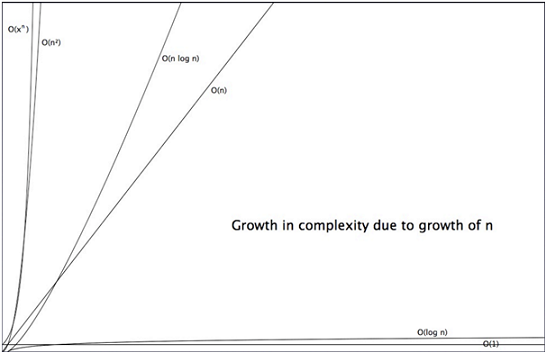Many developers I came across in my career as a software developer are only familiar with the most basic data structures, typically, Array, Map and Linked List. These are fundamental data structures and one could argue that they are generic enough to fit most of the commercial software requirements. But what worries me most is that even seasoned developers are not familiar with the vast repertoire of available data structures and their time complexity. In this post the ADTs (Abstract Data Types) present in the Java Collections (JDK 1.6) are enlisted and the performance of the various data structures, in terms of time, is assessed.
Before we start it is helpful to understand the so-called “Big O” notation. This notation approximately describes how the time to do a given task grows with the size of the input. Roughly speaking, on one end we have
O(1) which is “constant time” and on the opposite end we have
O(xn) which is “exponential time”. The following chart summarizes the growth in complexity due to growth of input (
n). In our data structure walk-through we sometimes use the symbol
h to signify the Hash Table capacity.
List
A list is an ordered collection of elements.
|
|
Add
|
Remove
|
Get
|
Contains
|
Data Structure
|
|
ArrayList
|
O(1)
|
O(n)
|
O(1)
|
O(n)
|
Array
|
|
LinkedList
|
O(1)
|
O(1)
|
O(n)
|
O(n)
|
Linked List
|
|
CopyonWriteArrayList
|
O(n)
|
O(n)
|
O(1)
|
O(n)
|
Array
|
Set
A collection that contains no duplicate elements.
|
|
Add
|
Contains
|
Next
|
Data Structure
|
|
HashSet
|
O(1)
|
O(1)
|
O(h/n)
|
Hash Table
|
|
LinkedHashSet
|
O(1)
|
O(1)
|
O(1)
|
Hash Table + Linked List
|
|
EnumSet
|
O(1)
|
O(1)
|
O(1)
|
Bit Vector
|
|
TreeSet
|
O(log n)
|
O(log n)
|
O(log n)
|
Red-black tree
|
|
CopyonWriteArraySet
|
O(n)
|
O(n)
|
O(1)
|
Array
|
|
ConcurrentSkipList
|
O(log n)
|
O(log n)
|
O(1)
|
Skip List
|
Queue
A collection designed for holding elements prior to processing.
|
|
Offer
|
Peak
|
Poll
|
Size
|
Data Structure
|
|
PriorityQueue
|
O(log n )
|
O(1)
|
O(log n)
|
O(1)
|
Priority Heap
|
|
LinkedList
|
O(1)
|
O(1)
|
O(1)
|
O(1)
|
List
|
|
ArrayDequeue
|
O(1)
|
O(1)
|
O(1)
|
O(1)
|
Linked List
|
|
ConcurrentLinkedQueue
|
O(1)
|
O(1)
|
O(1)
|
O(n)
|
Linked List
|
|
ArrayBlockingQueue
|
O(1)
|
O(1)
|
O(1)
|
O(1)
|
Array
|
|
PriorirityBlockingQueue
|
O(log n)
|
O(1)
|
O(log n)
|
O(1)
|
Priority Heap
|
|
SynchronousQueue
|
O(1)
|
O(1)
|
O(1)
|
O(1)
|
None!
|
|
DelayQueue
|
O(log n)
|
O(1)
|
O(log n)
|
O(1)
|
Priority Heap
|
|
LinkedBlockingQueue
|
O(1)
|
O(1)
|
O(1)
|
O(1)
|
Linked List
|
Map
An object that maps keys to values. A map cannot duplicate keys; each key can map to at most one value.
|
|
Get
|
ContainsKey
|
Next
|
Data Structure
|
|
HashMap
|
O(1)
|
O(1)
|
O(h / n)
|
Hash Table
|
|
LinkedHashMap
|
O(1)
|
O(1)
|
O(1)
|
Hash Table + Linked List
|
|
IdentityHashMap
|
O(1)
|
O(1)
|
O(h / n)
|
Array
|
|
WeakHashMap
|
O(1)
|
O(1)
|
O(h / n)
|
Hash Table
|
|
EnumMap
|
O(1)
|
O(1)
|
O(1)
|
Array
|
|
TreeMap
|
O(log n)
|
O(log n)
|
O(log n)
|
Red-black tree
|
|
ConcurrentHashMap
|
O(1)
|
O(1)
|
O(h / n)
|
Hash Tables
|
|
ConcurrentSkipListMap
|
O(log n)
|
O(log n)
|
O(1)
|
Skip List
|
转载: http://infotechgems.blogspot.hk/2011/11/java-collections-performance-time.html






















 3070
3070

 被折叠的 条评论
为什么被折叠?
被折叠的 条评论
为什么被折叠?








